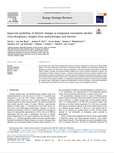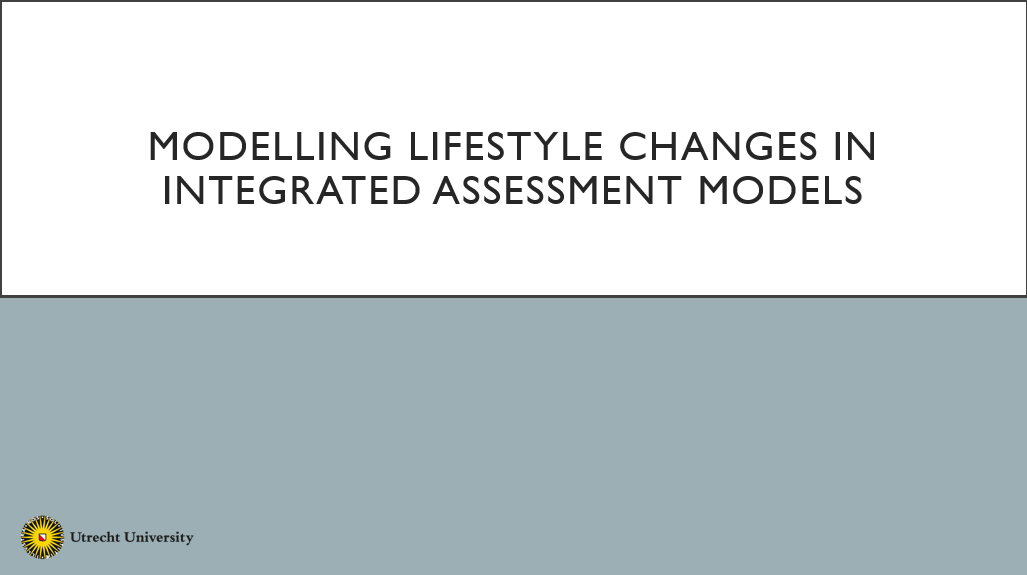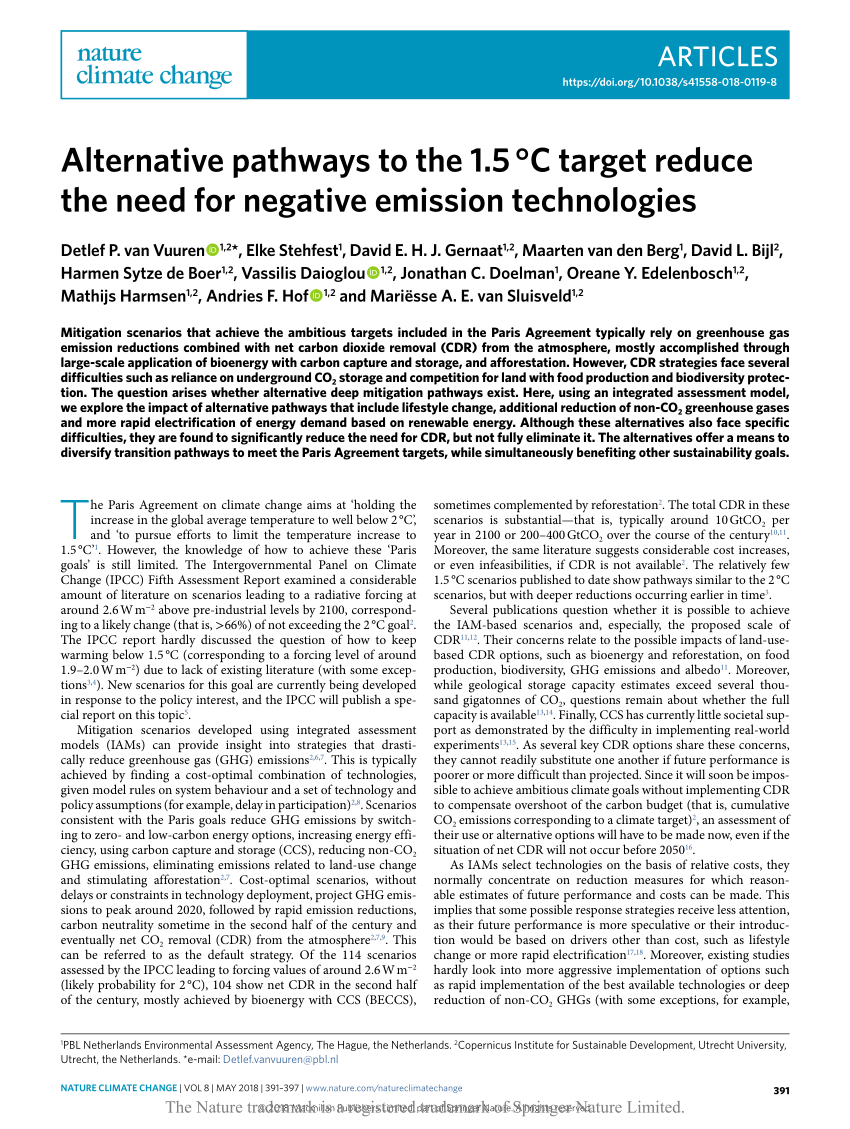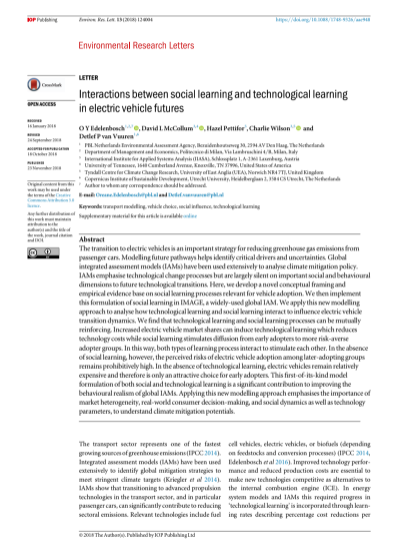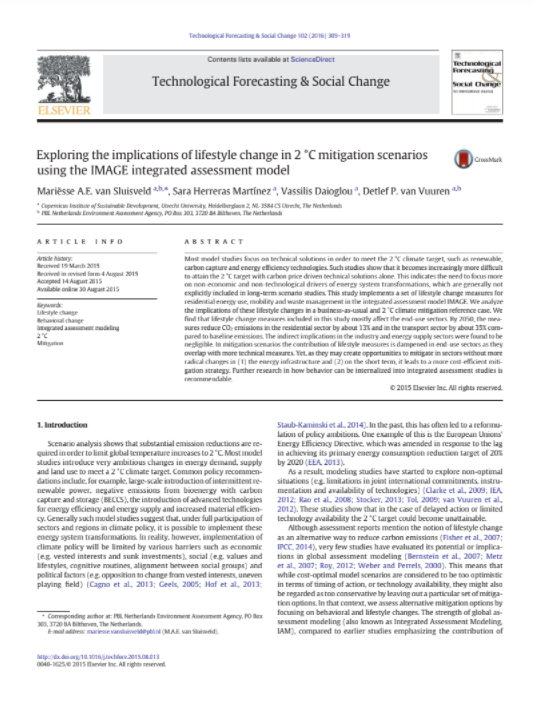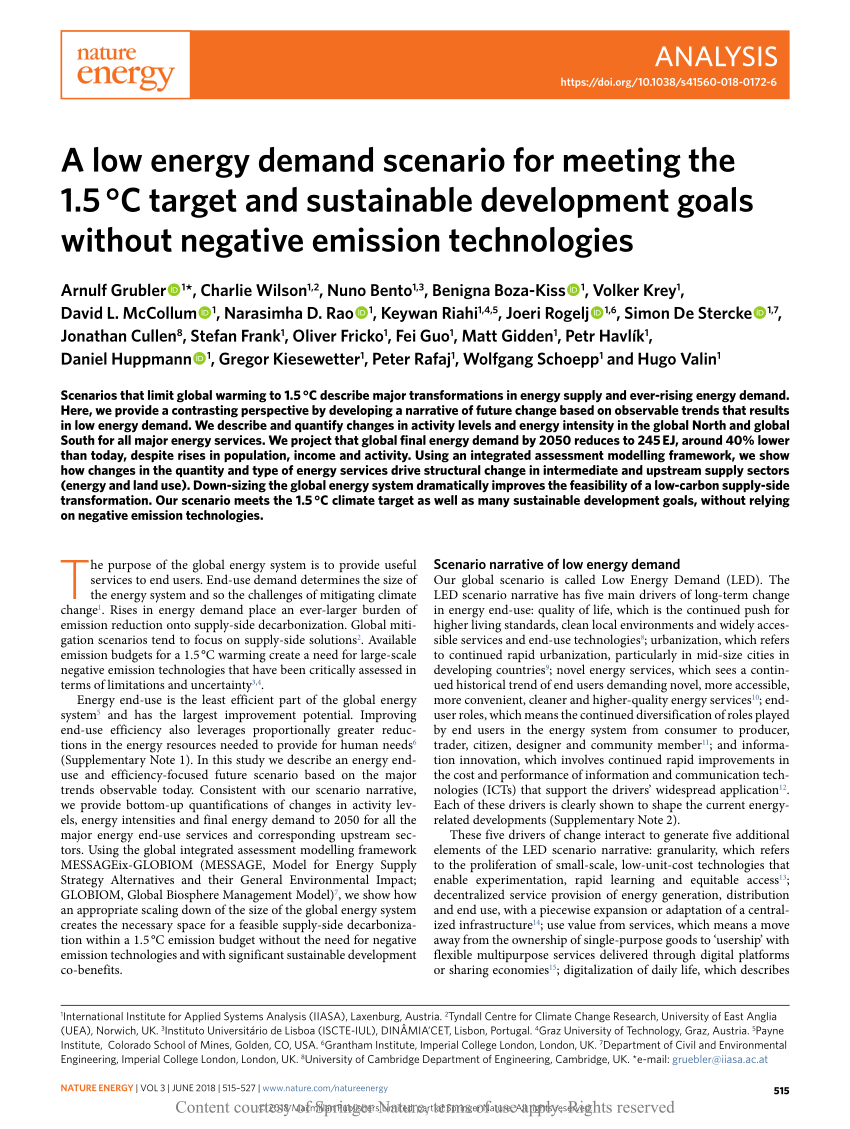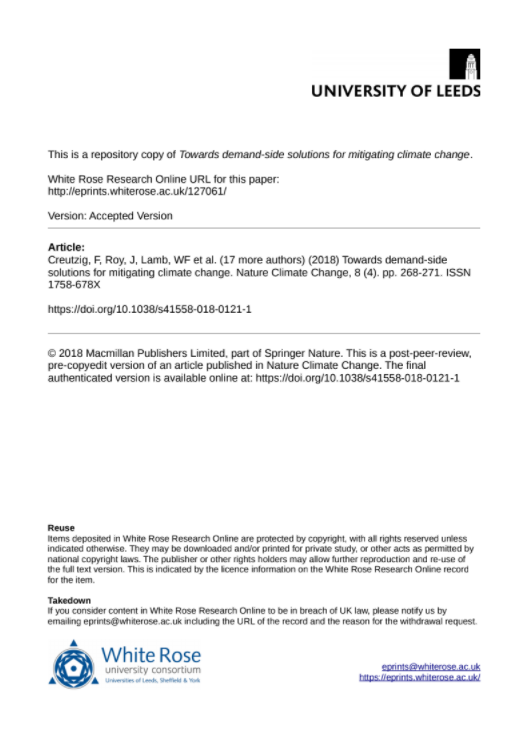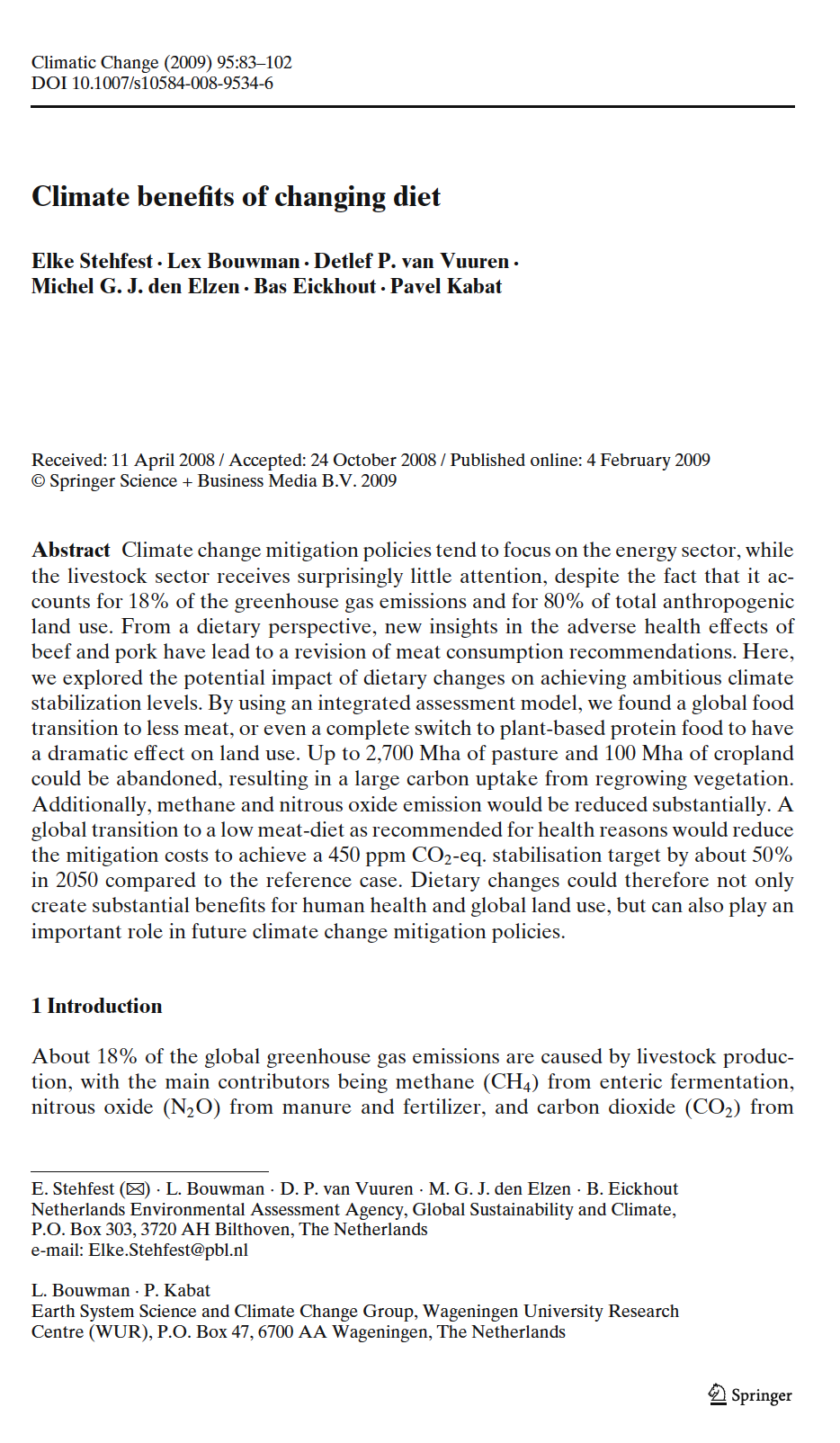Publications
2019 |
Improved modelling of lifestyle changes in Integrated Assessment Models: Cross-disciplinary insights from methodologies and theories
Nicole J. van den Berg, Andries F. Hof, Lewis Akenji, Oreane Y. Edelenbosch, Mariesse A.E. van Sluisveld,
Vanessa J. Timmer, Detlef P. van Vuuren
Vanessa J. Timmer, Detlef P. van Vuuren
|
Recent studies show that lifestyle changes can provide an essential contribution to achieving the Paris climate targets. While some efforts have been made to incorporate lifestyle changes into model-based scenarios, the attempts are currently very stylised and included exogenously. This paper discusses current efforts to represent lifestyle change in models, and analyses potential insights from relevant scientific disciplines to improve the representation of lifestyle changes in models – including modelling specific behaviour changes, identifying cross-cutting lifestyle solutions, representing the intentions behind the changes and quantifying their impacts. As such, this research attempts to bridge the gap between qualitative and quantitative theories and methodologies. Based on the results of this literature analysis, we recommend defining lifestyle changes more harmoniously, exploring an expanded range of approaches, domains and transformative solutions, adopting a whole-systems approach, and addressing the trade-offs between the use of exogenous inputs and endogenous modelling.
Energy Strategy Reviews https://www.sciencedirect.com/science/article/pii/S2211467X19301129?via%3Dihub |
Presentation
2018 |
Alternative pathways to the 1.5°C target reduce the need for negative emission technologies
|
Detlef P. van Vuuren, Elke Stehfest, David E. H. J. Gernaat, Maarten van den Berg, David L. Bijl,
Harmen Sytze de Boer, Vassilis Daioglou, Jonathan C. Doelman, Oreane Y. Edelenbosch, Mathijs Harmsen, Andries F. Hof, and Mariësse A. E. Sluisveld Mitigation scenarios that achieve the ambitious targets included in the Paris Agreement typically rely on greenhouse gas emission reductions combined with net carbon dioxide removal (CDR) from the atmosphere, mostly accomplished through large-scale application of bioenergy with carbon capture and storage, and afforestation. However, CDR strategies face several difficulties such as reliance on underground CO2 storage and competition for land with food production and biodiversity protection. The question arises whether alternative deep mitigation pathways exist. Here, using an integrated assessment model, we explore the impact of alternative pathways that include lifestyle change, additional reduction of non-CO2 greenhouse gases and more rapid electrification of energy demand based on renewable energy. Although these alternatives also face specific difficulties, they are found to significantly reduce the need for CDR, but not fully eliminate it. The alternatives offer a means to diversify transition pathways to meet the Paris Agreement targets, while simultaneously benefiting other sustainability goals. Nature Climate Change https://www.nature.com/articles/s41558-018-0119-8#auth-8 |
Interactions between social learning and technological learning in electric vehicle futures
O Y Edelenbosch, David L McCollum, Hazel Pettifor, Charlie Wilson, Detlef P van Vuuren
|
The transition to electric vehicles is an important strategy for reducing greenhouse gas emissions from passenger cars. Modelling future pathways helps identify critical drivers and uncertainties. Global integrated assessment models (IAMs) have been used extensively to analyse climate mitigation policy. IAMs emphasise technological change processes but are largely silent on important social and behavioural dimensions to future technological transitions. Here, we develop a novel conceptual framing and empirical evidence base on social learning processes relevant for vehicle adoption. We then implement this formulation of social learning in IMAGE, a widely-used global IAM. We apply this new modelling approach to analyse how technological learning and social learning interact to influence electric vehicle transition dynamics. We find that technological learning and social learning processes can be mutually reinforcing. Increased electric vehicle market shares can induce technological learning which reduces technology costs while social learning stimulates diffusion from early adopters to more risk-averse adopter groups. In this way, both types of learning process interact to stimulate each other. In the absence of social learning, however, the perceived risks of electric vehicle adoption among later-adopting groups remains prohibitively high. In the absence of technological learning, electric vehicles remain relatively expensive and therefore is only an attractive choice for early adopters. This first-of-its-kind model formulation of both social and technological learning is a significant contribution to improving the behavioural realism of global IAMs. Applying this new modelling approach emphasises the importance of market heterogeneity, real-world consumer decision-making, and social dynamics as well as technology parameters, to understand climate mitigation potentials.
Environmental Research Letters https://iopscience.iop.org/article/10.1088/1748-9326/aae948/pdf |
Exploring the implications of lifestyle change in 2 °C mitigation scenarios using the IMAGE integrated assessment model
Mariësse A. E. van Sluisveld, Sara Herreras Martínez, Vassilis Daioglou, Detlef P. van Vuure
|
Most model studies focus on technical solutions in order to meet the 2 °C climate target, such as renewable, carbon capture and energy efficiency technologies. Such studies show that it becomes increasingly more difficult to attain the 2 °C target with carbon price driven technical solutions alone. This indicates the need to focus more on non-economic and non-technological drivers of energy system transformations, which are generally not explicitly included in long-term scenario studies. This study implements a set of lifestyle change measures for residential energy use, mobility and waste management in the integrated assessment model IMAGE. We analyze the implications of these lifestyle changes in a business-as-usual and 2 °C climate mitigation reference case. We find that lifestyle change measures included in this study mostly affect the end-use sectors. By 2050, the measures reduce CO2 emissions in the residential sector by about 13% and in the transport sector by about 35% compared to baseline emissions. The indirect implications in the industry and energy supply sectors were found to be negligible. In mitigation scenarios the contribution of lifestyle measures is dampened in end-use sectors as they overlap with more technical measures. Yet, as they may create opportunities to mitigate in sectors without more radical changes in (1) the energy infrastructure and (2) on the short term, it leads to a more cost-efficient mitigation strategy. Further research in how behavior can be internalized into integrated assessment studies is recommendable.
Technological Forecasting and Social Change https://www.sciencedirect.com/science/article/pii/S0040162515002607?via%3Dihub |
Other Publications
A low energy demand scenario for meeting the 1.5 °C target and sustainable development goals without negative emission technologies
Arnulf Grubler, Charlie Wilson, Nuno Bento, Benigna Boza-Kiss, Volker Krey, David L. McCollum, Narasimha D. Rao, Keywan Riahi, Joeri Rogelj, Simon De Stercke, Jonathan Cullen, Stefan Frank, Oliver Fricko, Fei Guo, Matt Gidden, Petr Havlík, Daniel Huppmann, Gregor Kiesewetter, Peter Rafaj, Wolfgang Schoepp, Hugo Valin
|
Scenarios that limit global warming to 1.5 °C describe major transformations in energy supply and ever-rising energy demand. Here, we provide a contrasting perspective by developing a narrative of future change based on observable trends that results in low energy demand. We describe and quantify changes in activity levels and energy intensity in the global North and global South for all major energy services. We project that global final energy demand by 2050 reduces to 245 EJ, around 40% lower than today, despite rises in population, income and activity. Using an integrated assessment modelling framework, we show how changes in the quantity and type of energy services drive structural change in intermediate and upstream supply sectors (energy and land use). Down-sizing the global energy system dramatically improves the feasibility of a low-carbon supply-side transformation. Our scenario meets the 1.5 °C climate target as well as many sustainable development goals, without relying on negative emission technologies.
Nature Energy https://www.nature.com/articles/s41560-018-0172-6 |
Towards demand-side solutions for mitigating climate change
Felix Creutzig, Joyashree Roy, William F. Lamb, Inês M. L. Azevedo, Wändi Bruine de Bruin, Holger Dalkmann,
Oreane Y. Edelenbosch, Frank W. Geels, Arnulf Grubler, Cameron Hepburn, Edgar G. Hertwich, Radhika Khosla, Linus Mattauch,
Jan C. Minx, Anjali Ramakrishnan, Narasimha D. Rao, Julia K. Steinberger, Massimo Tavoni, Diana Ürge-Vorsatz,
Elke U. Weber
Oreane Y. Edelenbosch, Frank W. Geels, Arnulf Grubler, Cameron Hepburn, Edgar G. Hertwich, Radhika Khosla, Linus Mattauch,
Jan C. Minx, Anjali Ramakrishnan, Narasimha D. Rao, Julia K. Steinberger, Massimo Tavoni, Diana Ürge-Vorsatz,
Elke U. Weber
|
Research on climate change mitigation tends to focus on supply-side technology solutions. A better understanding of demand-side solutions is missing. We propose a transdisciplinary approach to identify demand-side climate solutions, investigate their mitigation potential, detail policy measures and assess their implications for well-being.
Nature Climate Change https://www.nature.com/articles/s41558-018-0121-1 |
Climate benefits of changing diet
Elke Stehfest; Lex Bouwman; Detlef P. van Vuuren; Michel G. J. den Elzen; Bas Eickhout; Pavel Kabat
|
Climate changemitigation policies tend to focus on the energy sector, while the livestock sector receives surprisingly little attention, despite the fact that it accounts for 18% of the greenhouse gas emissions and for 80% of total anthropogenic land use. From a dietary perspective, new insights in the adverse health effects of beef and pork have lead to a revision of meat consumption recommendations. Here, we explored the potential impact of dietary changes on achieving ambitious climate stabilization levels. By using an integrated assessment model, we found a global food transition to less meat, or even a complete switch to plant-based protein food to have a dramatic effect on land use. Up to 2,700 Mha of pasture and 100 Mha of cropland could be abandoned, resulting in a large carbon uptake from regrowing vegetation. Additionally, methane and nitrous oxide emission would be reduced substantially. A global transition to a lowmeat-diet as recommended for health reasons would reduce the mitigation costs to achieve a 450 ppm CO2-eq. stabilisation target by about 50% in 2050 compared to the reference case. Dietary changes could therefore not only create substantial benefits for human health and global land use, but can also play an important role in future climate change mitigation policies.
Climate Change https://link.springer.com/article/10.1007/s10584-008-9534-6 |
